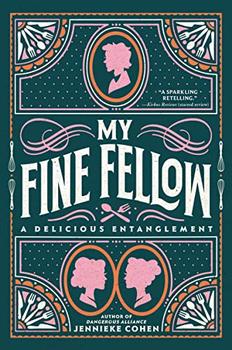Summary | Excerpt | Reviews | Beyond the Book | Read-Alikes | Genres & Themes | Author Bio

This article relates to My Fine Fellow
.jpg) Tracing Jennieke Cohen's My Fine Fellow and its influences through time offers a fascinating thread stretching back all the way to the ancient Greeks.
Tracing Jennieke Cohen's My Fine Fellow and its influences through time offers a fascinating thread stretching back all the way to the ancient Greeks.
Cohen's novel is a playful reworking of the musical My Fair Lady, about a snobbish English professor determined to make over a Cockney flower seller. The musical was written by composer Frederick Loewe and lyricist Alan Jay Lerner and had its premiere on Broadway in 1956, with a young Julie Andrews in the role of Eliza Doolittle. Just a few years later, in 1964, the wildly successful musical was adapted for the big screen, with Audrey Hepburn in the title role. The film won eight Oscars and was, at the time, the highest-grossing Warner Brothers film ever.
Lerner and Loewe (who also collaborated on such hits as Brigadoon and Camelot) took on the project after that other famous duo, Rodgers and Hammerstein, declared that basing a musical on the source material was impossible, and abandoned their own attempts at doing so.
So what was that source material, you may ask? It was George Bernard Shaw's play Pygmalion, which introduced the world to the characters of Henry Higgins, Eliza Doolittle and Colonel Pickering. Shaw's play, which was written in 1913 and had its London premiere in 1914, is an exploration of the relationship between language use and social class in early 20th-century England.
Shaw named his play after a classical myth (we'll get there!) and did so in part, it's thought, in order to make people think they were going to see a classical Greek play. He also chose to direct the play anonymously, hoping to trick audiences (and overly judgmental critics) into abandoning their preconceived notions about what a Shaw play was like. In addition to the myth, he may have been inspired by other sources, including a novel by Tobias Smollett—The Adventures of Peregrine Pickle, also about an upper-class gentleman attempting to make a "lady" out of a working-class young woman—and W. S. Gilbert's play Pygmalion and Galatea.
Both Gilbert's and Shaw's plays are based specifically on the Greek myth of Pygmalion and Galatea, the most famous retelling of which comes to us from the Roman poet Ovid's Metamorphoses. The story of Pygmalion and Galatea was just one of numerous stories of transformation—many collected from Greek mythology and translated into Latin verse—that comprised the Metamorphoses; other famous narratives include the tales of Jupiter and Io, Echo and Narcissus, and Orpheus and Eurydice.
In the Greek myth from which Ovid took his tale, Pygmalion is a king from Cyprus and the grandfather of Adonis. He is also a sculptor who, having sworn off sexual contact with human women, makes an ivory statue that represents the ideal female form. He then (naturally) falls in love with his creation, who (at least in later versions of the story) he names Galatea. In answer to his prayers, the goddess Aphrodite brings Galatea to life, and they have a child.
Ovid, Shaw, Lerner and Loewe, and Cohen are not the only creators to be inspired by the Pygmalion myth. The story has been a favorite subject of artists; painter Edward Burne-Jones famously created a four-panel painting outlining it. Another famous painting by Jean-Léon Gérôme, now at the Metropolitan Museum of Art, vividly depicts the Galatea sculpture at the moment of transformation. The Pygmalion myth has also resulted in operas by Jean-Philippe Rameau and Gaetano Donizetti, and Shaw's play and its offshoots have influenced films like Educating Rita, Pretty Woman and She's All That as well as the short-lived sitcom Selfie.
The Heart Desires, Pygmalion (I of IV), Second Series by Edward Burne-Jones
Filed under Music and the Arts
![]() This "beyond the book article" relates to My Fine Fellow. It originally ran in March 2022 and has been updated for the
January 2023 paperback edition.
Go to magazine.
This "beyond the book article" relates to My Fine Fellow. It originally ran in March 2022 and has been updated for the
January 2023 paperback edition.
Go to magazine.
Your guide toexceptional books
BookBrowse seeks out and recommends the best in contemporary fiction and nonfiction—books that not only engage and entertain but also deepen our understanding of ourselves and the world around us.